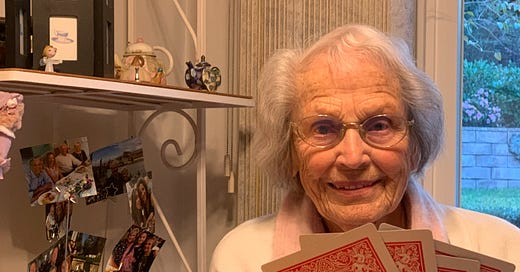A Quiet Ritual for a Centenarian's Focused Mind
Simple hobbies can bring joy and mental stimulation.
Welcome to a newsletter themed at the intersection of longevity and wine history. 🍷
Trash-talking at 103: Grandma Kay’s jumbo-size cards are as big as her ambition to beat me at her favorite games.
Grandma Kay is four months away from turning 104. Shortly after becoming a centenarian, I took her to a clinic for a routine blood test. When we checked in, the lab technician peeked at her I.D. His eyes widened as he saw her age. Then, he asked: “What’s your longevity secret, Mrs. Gemello?”
“I like to color and watch my favorite TV shows. I just live one day at a time.”
He smiled at the simplicity of her answer. It turns out, medical professionals say coloring is a form of meditation for many pushing into their nineties and older. Grandma Kay’s bedroom has stacks of coloring books filled with color-by-number intricate patterns. Flowers. Animals. Artwork. She colors while watching TV.
It helps her stay in the moment, rather than stress over things she can’t control. (One of her pet peeves: a windstorm scattering leaves that she just raked into a pile for her gardener the day before he comes.)
The lab technician posed another question about a cognitive, or brain-stimulating activity, that many associate with longevity: “Do you do crossword puzzles?”
“No, but I play Chinese Checkers with my grandson,” she told him.
Cognitive activities like these may help reduce the risk of dementia, according to Dr. Tom Perls, founder of the New England Centenarian Study. Grandma Kay is a participant in the study.
Perls describes cognitive activities as a way to “develop new connections in the brain.”
“My analogy is, if you think of in the Midwest along the railroad tracks, there are these telephone wires that have lots and lots of wires, not just one wire. And if you want to decrease the communication from one part of the country to the other you have to start snipping at the wires. But if there are more wires to snip at, you have to snip at more and more wires before there is a problem,” Perls explains.
He adds, “Along the same lines, if there is a neurodegenerative [disorder] occurring, but you’ve done cognitive activities that increases the number of connections, it’s going to take longer to cause a problem.”
“Along the same lines, if there is a neurodegenerative [disorder] occurring, but you’ve done cognitive activities that increases the number of connections, it’s going to take longer to cause a problem,” Perls says.
Perls further analogized if weightlifting is the most efficient way to train your physical muscles, then the best way to exercise your brain would be to learn a new musical instrument or a new language.
“Those are hard to do, but the more you do it, it becomes easier,” he says. “It’s probably because of the new connections you’re making.”
He says that if you aren’t willing to do the difficult things, at least do something that’s new and different.
“Like painting, then do sculpture or take up reading or crossword puzzles or Sudoku. Once you get good at those things, then do something new that you’re not as good at,” he says.
A Brain-Healthy Lifestyle
Neuroscientist
writes in her Better Brain Substack blog that it’s important to think of brain health as “a lifestyle.”“To keep the brain healthy requires social connection, learning, sleep, nutrition, exercise and more,” she writes.
In a recent post, she shares with her readers 3 brain exercises better than crossword puzzles. (If you’re not a paid subscriber to her blog, here’s a coupon for a two-week trial).
If you’re new here—hi, I’m Kevin!
I’m the author of 🍷 Rain on the Monte Bello Ridge,🍷 my forthcoming memoir about health, aging and winemaking. (Read the origin story of the book.) 🍇
The Centenarian Playbook is my newsletter, which features:
Healthy aging/longevity tips and stories from Grandma Kay’s long life.
Wine history & stories of the Gemello Winery
Ancestry & family research tips
There are three buttons at the bottom of every post: “like,” “comment,” and “restack.” Restacking is sharing in digital form. It goes out to the Substack community. If you enjoy the content and click “Restack,” it helps a lot.





Hi Kevin, This is excellent information. I love the coloring idea—it can be therapeutic as well. Reading about crossword puzzles and the need for socialization - also very important.
Kevin,
Another wonderful letter. You are the best and I know that your book will be fantastic.
Do save me a copy. I'll cash in my pennies to pay for the book. Take care, Phil